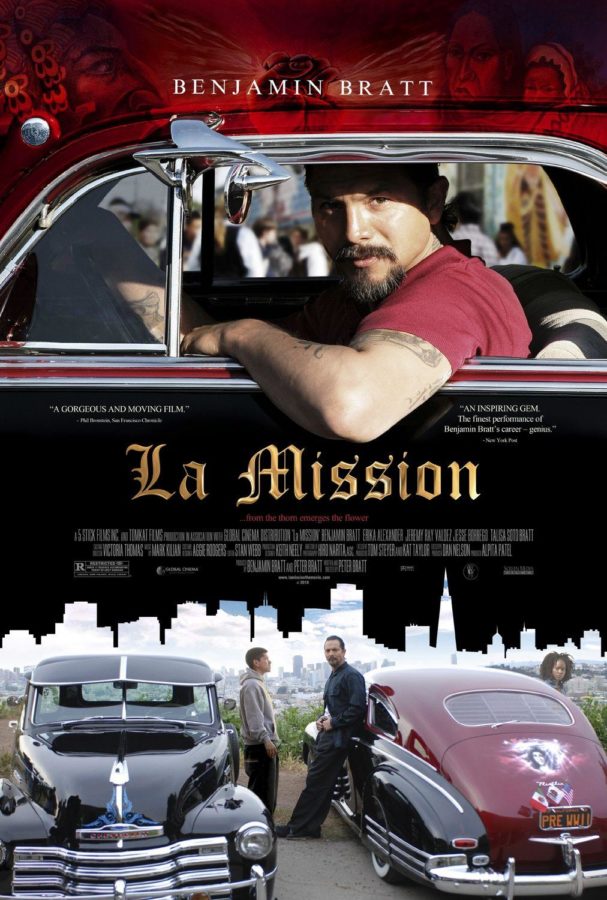Directed and written by Peter Bratt, the 2009 film “La Mission” made its way from the Sundance Film Festival to our very own Santa Rosa Junior College campus Oct. 14.
The film features the director’s brother Benjamin Bratt as a traditionally minded, religious, violent, macho Latino named Che, who is a mechanic, ex-convict and father to a mild-mannered and sympathetic boy named Jes (Jeremy Ray Valdez) living together in the Mission District of San Francisco.
However, there is a twist: Jes accidentally reveals that he is gay, and his father is not ready to cope with this discovery. This leads to heart-wrenching scenes between two opposing viewpoints that cannot understand each other. Their calm, accepting and feminist New Age black neighbor Lena serves as a liaison between the two and shows them a new way to come to terms with their differences.
“La Mission” artfully blends several themes together over its two-hour run time, including LGBT and biracial relationships and the friction between old-world and modern values. The film is a drama, but also humorous. The soundtrack ranges from traditional tribal pieces to more urban city beats, depending on the mood and scene.
Latino culture makes up a huge part of the aesthetic, including painted murals, folk dancing and even lowrider cars. In fact, Bratt said cult followings for the film have sprung up in Spain and Japan due to fans of lowrider culture and music. But there are still more examples of cultures from around the globe — Lena’s apartment has Tibetan prayer flags and a statue of the Hindu goddess Kali.
After the screening, there was a Q-and-A session. As a political science student in college, Bratt originally wished to be a teacher but decided to take a film class as his chance to relax. Instead they were expected to write a paper every week.
He was also taking a class that exposed him to Marxist and feminist points of view at the time. “That opened up and expanded my view,” Bratt said. “After taking that course, I realized that my perceptions were shaped by what I saw on the big screen.”
And he wasn’t happy with what he saw. The characters on the screen did not match up to his reality. “I really just wanted to write about people I knew,” he said. He grew up in the ’60s and ’70s, when there were Chicano movements, Indian movements and Black Power movements. “It became the excitement of not being ashamed of who you are,” Bratt said.
His inspiration for many of the characters in the film come from a mixture of relatives and friends from his own past in the Mission District. In one scene, a bully from Jes’ school takes the bullying a step further and physically injures him. Bratt said this was a direct parallel to the experience of his relative, who is gay; his father had told him, “You’re dead to me” upon discovering his sexuality. But there is a silver lining in this parallel story, which you will see when you watch it on-screen.
Bratt’s respect for feminism shines through in “La Mission,” mainly through the character Lena. “In a lot of non-Western cultures, the regard and respect for the feminine was high,” the director said. “But that changed with colonization. We’ve lost a lot of the value of the story.”
Che, who represents the patriarchy, is used to navigating through life and getting his way with brute force, physical power and intimidation, but there is conflict when he runs into his next-door neighbor Lena. “He has to come into contact with this feminine force who has a whole different view of power,” Bratt said. Che is not used to this kind of confrontation, and eventually has to learn a new method of living.
Bratt elaborated on why he feels the need to share his art. “The majority of storytellers are Anglo,” he said. “We’re not really participating in the story creation. The world needs a new story to live by.”
Student Ambassador Angel Torres was happy to help out with the “La Mission” film screening. “It brings to memory some things that happened for me,” Torres said. “It relates to me.”
The movie can be somewhat cheesy in a few choice instances with its usage of “you-know-what-I’m-sayin” lingo and slang, but overall it is very genuine and heartfelt. If you have a chance to watch it, please do.



M. Villan • Nov 4, 2014 at 11:43 am
I saw this movie because I love Benjamin Bratt but I was disappointed because it stereo typed the Hispanic (Mexican) culture. Low-rider cars, poverty, sex. I though Benjamin was better than this, and it did not show his real talent. I still love him but I hope he chooses better roles.